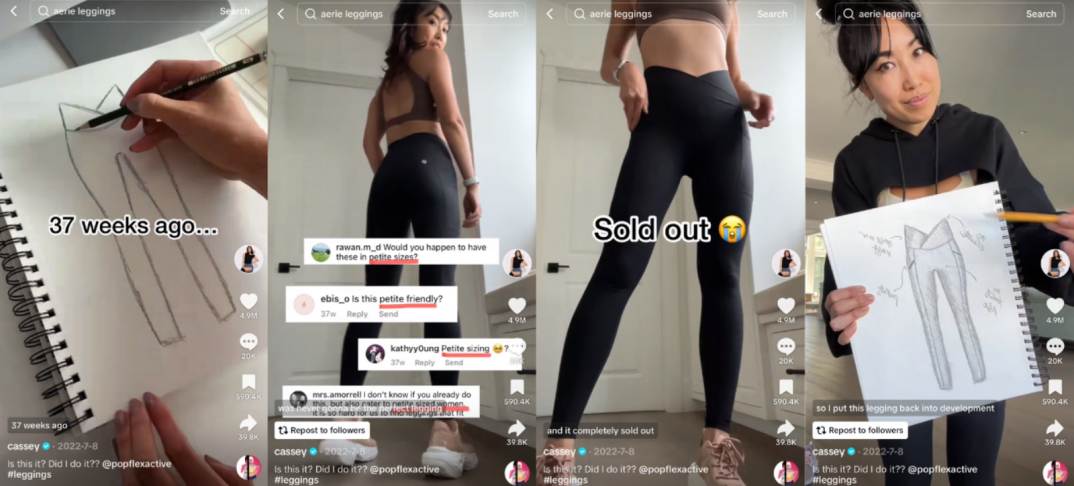Cassey Ho, Founder and CEO of POPFLEX, shares her activewear designs from sketch to final product
Cherie Luo
Do you know who created your favorite brand? What’s their story, and does knowing it make you trust them more? Today, more entrepreneurs are lifting the curtain on their business journeys, sharing not only the finished product but the process of building it. This openness shifts the customer-brand relationship from transactions to a partnership that emphasizes transparency and authenticity. Done well, founder-led marketing brings customers into the heart of design and development, turning them from passive buyers into invested participants with a stake in the brand’s success.
This movement of building in public redefines how brands engage with customers, creating a two-way relationship that goes beyond transactions. A building-in-public strategy done well can be a decisive factor—when two brands stand side-by-side, the one inviting its audience into its journey will win every time.
The Rise of Founder-Led Marketing
Founder-led marketing, where founders openly share their journey with the public, brings a personal touch to brand building that goes beyond traditional advertising. By revealing their process—often through social media—founders allow customers to experience the real ups and downs of business development. This transparency fosters a level of intimacy and trust that’s hard to replicate with faceless brands.
Today’s consumers, especially social media natives, are drawn to the authenticity of a founder simply telling their story. Eric Wei, co-founder of Karat and host of the JOMO podcast, sees founder-centered storytelling as the future of brand connection: “There’s an explosion of founder-led marketing right now because it’s coming from a genuine place,” Wei explained. “People want to know the real story and see the faces behind the brands they support.” For Wei, this shift reflects a broader trend—one where people connect more with individuals than with faceless companies. “That’s why companies started working with creators in the first place—to bring a human voice to their mission.”
Cassey Ho, founder of fitness brands Blogilates and POPFLEX with over 19M followers across social media platforms, is a powerful example of founder-centric storytelling. She focuses on the customer in every decision. For Ho, the design process is an ongoing conversation with her audience, captured in her “design with me” series. In these videos, she opens up feedback and decision-making on materials, cuts, and colors, often polling her followers and incorporating their input to refine fashion designs for her activewear brand POPFLEX. And when a design isn’t resonating, she goes back to the drawing board to make adjustments based on what her community wants: “When I started showing people the why behind the design, that really changed the game because people love understanding the journey of the product,” Ho said. This continuous feedback loop has become a hallmark of her brand. Cassey’s approach underscores her commitment to design with the customer in mind; her audience’s opinions are not only welcome but essential.
Cassey Ho’s TikTok account, Blogilates, sharing her design process with her followers.
Cherie Luo
Ho’s storytelling style through short-form video is crafted specifically for platforms like TikTok and Instagram where vertical video dominates. Her videos have an organic feel that blends seamlessly into viewers’ feeds, making them feel more like a friend’s update than a brand promotion: “It’s so much more than just selling a product; it’s about creating a community,” Ho said. Cassey’s videos don’t come across as marketing; rather, they feel like a shared journey, deepening the bond between her and her customers from the first sketch to the final product try-on.
Drawbacks of Founder-Led Marketing
While founder-led marketing brings authenticity and trust, it’s not without its challenges. Opening up the journey to the public can expose founders to intense scrutiny, online criticism, and the risk of competitors copying their ideas. “Building in public means every success and setback is visible,” said Nadya Okamoto, founder of period care company August, who has over 5M followers across social media. “When you build in public, you win really publicly, and you lose really publicly.” While transparency builds community, it also invites constant feedback, which can be challenging in sensitive industries like menstrual care.
This level of visibility requires a careful balance between openness and strategic discretion, as founders navigate how much to share without compromising their vision or mental well-being. “The pressure is real, and the criticism can feel overwhelming,” Okamoto said, emphasizing the need for resilience to manage public scrutiny. Ho echoed this sentiment, describing how her viral designs on TikTok and Instagram have led to fast-fashion giants replicating her work: “I knew in my bones that if something went viral, it was going to get copied.” While building in public presents obstacles like vulnerability to criticism and idea theft, it also opens the door to powerful real-world outcomes.
Nadya Okamoto’s viral videos on TikTok sharing her entrepreneurial journey.
Cherie Luo
Real-World Outcomes
Building in public isn’t just about storytelling—it can also drive immediate sales. When Cassey Ho shared her POPFLEX “perfect leggings” design process, she didn’t just post a product; she created a sense of shared ownership. The result was a viral video that received over 25 million views, 150,000 clicks, and leggings that sold out within hours—proof that when audiences feel genuinely involved, their support goes beyond likes and comments, translating into real demand and direct investment.
Similarly, my sister Jean Luo and I have seen the benefits of this approach with Sisters Matcha, our tea brand built with a series of behind-the-scenes videos. We take a call-and-response approach, with each new video inspired by feedback and questions from previous audience engagement. In this way, our followers shape both our product and our content direction, making them an integral part of the creative process. “We’re in constant dialogue with our community,” said Jean Luo. “By taking on roles as founders, product developers, content creators, and customer service reps, we’re co-creating a brand with our community that feels just as much theirs as it is ours,” Luo concluded.
Sisters Matcha building in public across platforms like LinkedIn, Instagram, and YouTube.
Cherie Luo
We’re also syndicating the Sisters Matcha journey to LinkedIn, which allows us to connect with a wider audience, including potential investors and industry supporters who may not present on other social platforms. LinkedIn’s professional focus gives us the opportunity to showcase our process and engage with those who are more attuned to the entrepreneurial side of our journey. For investors, especially in early-stage ventures, having a clear view of a founder’s values and working style is invaluable. By building in public, Jean and I are not only inviting customers into our brand’s story but also giving potential investors a rare, unfiltered look into parts of the founder’s journey that are usually hidden away.
A different example of founder-led marketing that stands out is Eric Wei’s recurring pickleball meetups in Los Angeles for creators, hosted by his company Karat. Unlike typical feedback sessions where companies bring in paid participants for structured insights, Wei’s events have a more personal vibe: creators show up, much like a group of friends, to connect over a pickleball match or two. There’s no compensation or formal feedback process; instead, the recurring nature of these meetups fosters community. Over time, this approach keeps creators returning, drawn by the sense of belonging and mutual support: “Our mission has always been to support creators, but being able to sit down with them face-to-face lets us really understand what they need to succeed,” Wei explained. He sees that creators thrive in settings where they can openly share not only successes but also struggles. This relaxed environment fosters a sense of trust and camaraderie as creators discuss everything from content strategy to burnout—conversations that directly influence Karat’s offerings in meaningful ways.
Creators gather for Pickleball event
Eric Wei
Building in public like this yields outcomes that reach beyond basic engagement; it deepens trust and turns casual customers into loyal stakeholders. Founders like Cassey Ho, Nadya Okamoto, Jean Luo, and Eric Wei show that by making customers part of their journey, brands don’t just receive feedback—they cultivate invested communities that believe in the brand’s long-term success.
How to Get Started
Engaging in founder-led marketing doesn’t require an elaborate blueprint or a massive following; instead, it begins with the commitment to transparent storytelling and a willingness to bring people into the brand’s inner workings. This process involves actively sharing both wins and setbacks, building a real-time narrative that invites customers to see the decisions, pivots, and motivations shaping the product. By letting customers witness these moments, founders can foster a sense of ownership and loyalty within their audience. Ho, for example, frequently polls her audience directly on Instagram stories about design choices and even returns to the drawing board when feedback suggests a shift. This creates a direct line between the customer’s voice and the product, building trust that is difficult to achieve through traditional marketing.
While building in public can be challenging, especially in moments of criticism or uncertainty, the approach is uniquely suited to today’s consumer landscape, where authenticity is key. This model of engagement not only builds a loyal customer base but also allows founders to stay closely aligned with the real needs and desires of their audience. For those willing to commit, founder-led marketing is more than a strategy; it’s a long-term investment in creating a brand that truly connects with its customers.
Questions for Reflection
- If you were to build your brand in public, what aspects of your journey would you feel comfortable sharing or not sharing?
- How do you think showing both wins and challenges might impact the way people perceive your brand?
- How might interactive challenges or decision-making opportunities encourage your customers to feel more invested in your brand?
Acknowledgments
A special thanks to Jean Luo, Nadya Okamoto, Cassey Ho, and Eric Wei for their contributions to this conversation.
Follow me on Instagram or LinkedIn. Check out my website.




